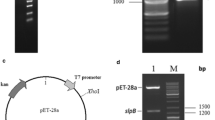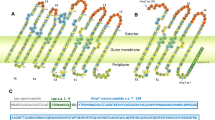Abstract
S-layer protein of Bacillus thuringiensis strain CTC was used as the carrier protein to display polyhistidine (poly[6His]) peptides on the cell surface. Poly(6His) n was fused with S-layer protein at two different sites, inserting just downstream of the S-layer protein homologous domain (slh) and replacing the non-slh region of S-layer protein, respectively. The two series chimeric proteins were both expressed by crystal negative B. thuringiensis strain 4Q7 and strain 171, respectively, as shown by sodium dodecyl sulfate polyacrylamide gel electrophoresis. The recombinant B. thuringiensis cells gained Ni2+- and Cd2+-binding ability and had a capacity to display up to nine copies of poly(6His). The Cd2+ adsorption quantity of the recombinant strain with the strongest adsorption ability was twice that of the host strain.
Similar content being viewed by others

References
Sára, M. and Sleytr, U. B. (2000), J. Bacteriol. 182, 859–868.
Sleytr, U. B., Messner, P., Pum, D., and Sára, M. (1999), Angew. Chem. Int. Ed. 38, 1034–1054.
Mesnage, S., Fontaine, T., Mignot, T., Delepierre, M., Mock, M., and Fouet, A. (2000), EMBO J. 17, 4473–4484.
Umelo-Njaka, E., Nomellini, J. F., Bingle, W. H., Glasier, L. G., Irvin, R. T., and Smit, J. (2001), Vaccine 19, 1406–1415.
Mesnage, S., Tosi-Couture, E., and Fouet, A. (1999), Mol. Microbiol. 31, 927–936.
Sousa, C., Cebolla, A., and Lorenzo, V. D. (1996), Nat. Biotechnol. 14, 1017–1021.
Xu, Z. H. and Lee, S. Y. (1999), Appl. Environ. Microbiol. 65, 5142–5147.
Samuelson, P., Wernerus, H., Svedberg, M., and Stahl, S. (2000), Appl. Environ. Microbiol. 66, 1243–1248.
Sun, M., Zhu, C.-G., and Yu, Z.-N. (2000), Acta Microbiol. Sin. 41, 141–147 (in Chinese).
Mesnage, S., Haustant, M., and Fouet, A. (2001), Microbiology 147, 1343–1351.
Etienne-Toumelin, I., Sirard, J. C., Duflot, E., Mock, M., and Fouet, A. (1995), J. Bacteriol. 177, 614–620.
Li, L. and Yu, Z.-N. (1999), Chin. J. Appl. Environ. Biol. 5, 395–399 (in Chinese).
Schurter, W., Geiser, M., and Mathe, D. (1989), Mol. Gen. Genet. 218, 177–181.
Janssen, G. R. and Bibb, M. J. (1993), Gene 124, 133, 134.
Arantes, B. and Lereclus, D. (1991), Gene 108, 115–119.
Sambrook, J., Fritsch, E. F., and Maniatis, T. (1989), Molecular Cloning: A Laboratory Manual, 2nd ed., Cold Spring Harbor Laboratory Press, Cold Spring Harbor, NY.
Mesnage, S., Weber-Levy, M., Haustant, M., Mock, M., and Fouet, A. (1999), Infect. Immun. 67, 4847–4850.
Schnepf, E., Crickmore, N., Van Rie, J., Lereclus, D., Baum, J., Feitelson, J., Zeigler, D. R., and Dean, D. H. (1998), Microbiol. Mol. Biol. Rev. 62, 775–806.
Author information
Authors and Affiliations
Corresponding author
Rights and permissions
About this article
Cite this article
Wang, L., Sun, M. & Yu, Z. Capacity of Bacillus thuringiensis S-layer protein displaying polyhistidine peptides on the cell surface. Appl Biochem Biotechnol 119, 133–143 (2004). https://doi.org/10.1385/ABAB:119:2:133
Received:
Revised:
Accepted:
Issue Date:
DOI: https://doi.org/10.1385/ABAB:119:2:133



